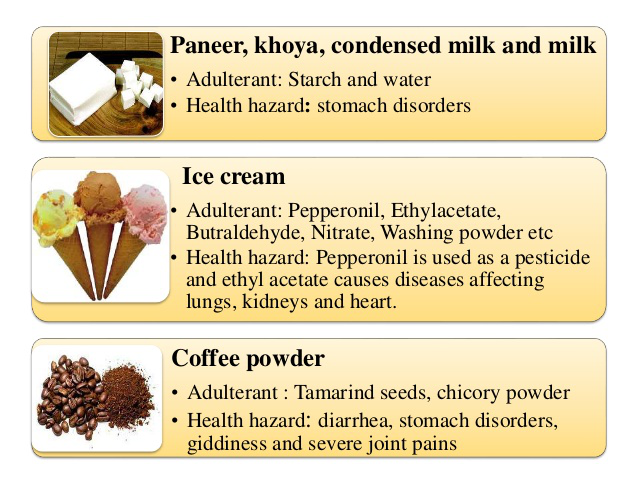Know Your Food! before You Use It!!
The process of cooking involves a lot of ingredients to bring the final taste, flavour and texture to the food. However, the ingredients which are sold in the market cannot be certified as pure. The lack of naturalness has become a major concern in today’s world.
Several reports of adulteration in some of the common ingredients used in our daily diet can be easily found on the Internet.
Food adulteration is the process in which the food quality standard is degraded the addition of low-quality components or by the extraction of valuable ingredient or nutrients. Adulterants are those substances which are added during the processing of the food products and are unsafe for human consumption.
The adulterated food products can cause severe health concerns such as Food poisoning, Stomach ache, indigestion, nausea, allergic or inflammatory reactions, infections, cough and fever.

There are certain simple tests that can be done to check the adulterated food products.
Coriander Powder is usually mixed with husk. To test it, we must take a teaspoon of the coriander powder in a glass of water and stir it well. The actual coriander powder will settle at the bottom of the glass, while the husk will float up on the water surface.
Sugar is sometimes adulterated with chalk powder. To detect it, stir a spoonful of it in a glass of water for a few minutes. If the solution becomes white with residue at the bottom, it indicates the presence of chalk. If chalk is not present, the solution will be transparent.
Milk can be adulterated with detergent. To detect it, mix ten millilitres of milk with ten millilitres of water. Shake it for a few minutes. If there is detergent present, a dense lather will form. Pure milk will instead have a thin layer of foam.
Butter can sometimes be adulterated with vegetable oil. To detect it, melt some butter, put it in a transparent container, and add a pinch of sugar. Shake it and then let it sit for five minutes. The presence of vegetable oil is indicated by a red colour at the bottom of the container.

International Conference on Food Safety and Hygiene
September 06-08, 2018
Edinburgh, Scotland
For more details, visit: https://goo.gl/VT7AXV
Several reports of adulteration in some of the common ingredients used in our daily diet can be easily found on the Internet.
Food adulteration is the process in which the food quality standard is degraded the addition of low-quality components or by the extraction of valuable ingredient or nutrients. Adulterants are those substances which are added during the processing of the food products and are unsafe for human consumption.
The adulterated food products can cause severe health concerns such as Food poisoning, Stomach ache, indigestion, nausea, allergic or inflammatory reactions, infections, cough and fever.

There are certain simple tests that can be done to check the adulterated food products.
Coriander Powder is usually mixed with husk. To test it, we must take a teaspoon of the coriander powder in a glass of water and stir it well. The actual coriander powder will settle at the bottom of the glass, while the husk will float up on the water surface.
Sugar is sometimes adulterated with chalk powder. To detect it, stir a spoonful of it in a glass of water for a few minutes. If the solution becomes white with residue at the bottom, it indicates the presence of chalk. If chalk is not present, the solution will be transparent.
Milk can be adulterated with detergent. To detect it, mix ten millilitres of milk with ten millilitres of water. Shake it for a few minutes. If there is detergent present, a dense lather will form. Pure milk will instead have a thin layer of foam.
Butter can sometimes be adulterated with vegetable oil. To detect it, melt some butter, put it in a transparent container, and add a pinch of sugar. Shake it and then let it sit for five minutes. The presence of vegetable oil is indicated by a red colour at the bottom of the container.

International Conference on Food Safety and Hygiene
September 06-08, 2018
Edinburgh, Scotland
For more details, visit: https://goo.gl/VT7AXV
Comments
Post a Comment